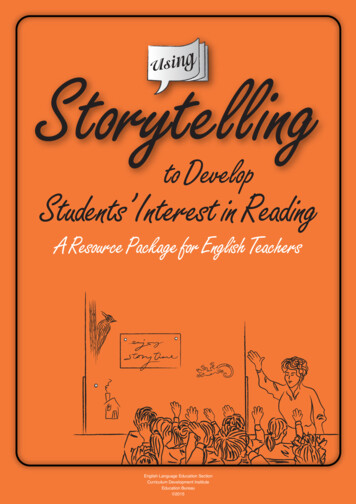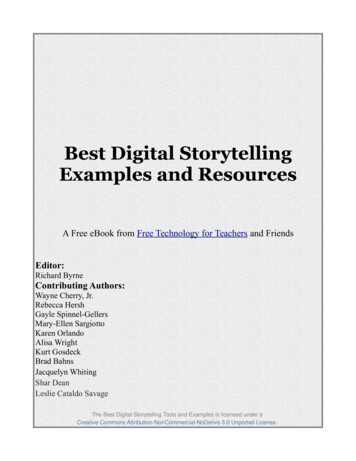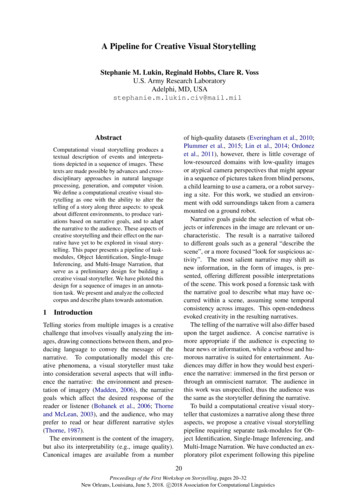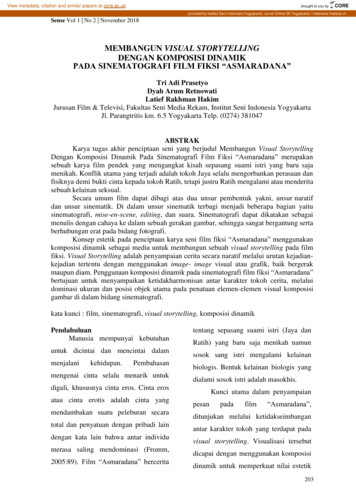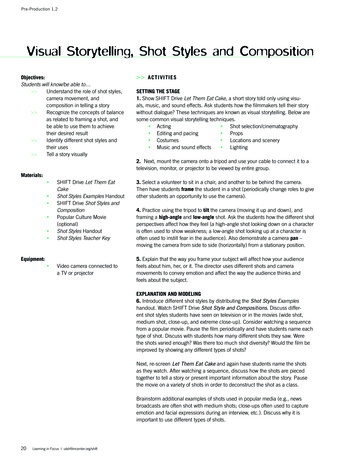
Transcription
BOOKSThe Seven Pillarsof StorytellingFfion Lindsay
Copyright 2015 SparkolAll rights reservedPublished by: Sparkol BooksPublished: December 2015Illustrations: Ben BinneySparkol BooksBristol, UKhttp://sparkol.com/books
Keep this book freeWe’ve written this book to help you engage youraudience through storytelling. Sharing it with just oneother person spreads the word and helps us to keep itfree. Thank you for clicking.TweetFacebookG Pin itScoop itLinkedIn
ForewordIf I were an architect designing a building I wouldlook to nature – to the great creator, to God, if you like– for structures and principles, for design and style,for strength and beauty and for methods that haveevolved over time.As communicators, we can do the same.In this book reams of theory has beendistilled into practical, simple toolsfor understanding and applying thepower of story.Ever thought why as evolved beings we don’t havemore useful dreams at night? Why no one dreamsin bullet points? Why the film industry is so large?Or why the gaming industry – which loves narrativebased games – is even larger? Why we paint the day instories, not facts, when we come home to our families?In the Middle East, centuries ago, a bearded man, afamiliar boy who’d grown and looked like any other,trained in his father’s humble profession, stepped outon to a mountain and delivered simple stories thathave been repeated ever since.Jesus, for me the most effective communicator thereever was, used parables. The man who claimed to beGod spoke in simple stories. Stories about things thateveryone could relate to, but not everyone interpreted
The Seven Pillars of Storytelling 5or completely understood. Why didn’t he expand?Why didn’t he explain the context and tell people howto apply this knowledge to their lives? How come thisbig picture, abstract delivery and metaphorical storyhas left his messages resonating, relevant and powerful in the world today, 2,000 years on?Imagine a man, working a normal job in a normaloffice in a very normal city. Holding yet another meeting around another table in another grey room. A TVdisplays the words he is saying; the occasional chartfrom Excel. He travels home on the train avoidingeye contact with his fellow commuters. Yet when hearrives home to two excited children, he throws off hisjacket, loosens his tie and he’s alive. In his own housethe man becomes a prince, a witch, a gorilla, the fairprincess herself, then a monster, acting out an entirewedding – leaving his audience happy and enthralled.In this book reams of theory has been distilled intopractical, simple tools for understanding and applyingthe power of story.I hope it goes some way to inspire us all to push creativity into work and education as we take increasingsteps to use story, art and our God-like nature to connect with our audiences.- Jon Air, Sparkol Founder
ContentsIntroduction:The power of story Emotion:How to give your story a heart Plot:The 7 universal story plots that entrance audiences Structure:8 Classic techniques for engaging stories Voice:The 12 archetypes all successful brands use Hero:How to make your customer the hero Villain:How to create a perfectly evil baddie Conflict:8152029436367Crunching battles that add to a story 76Final word82Sparkol’s story83
Introduction:The power of storyImagine booking in to your Las Vegas hotel. Youmake your way to your room and begin to unpack but– horror! You forgot to bring your favourite going-outshoes.You bought them on the internet so you jump onlineto see if you can get another pair delivered to the hotel.But they’re no longer on the site. Worried, you call theretailer’s concierge service. Unfortunately they don’tstock the shoes any longer and, dejected, you assumethat’s the end of the story. It’s not.The company’s headquarters are just outside LasVegas. The team immediately tracks down a pair of theshoes at a rival store in a local mall. They then drivedowntown, purchase the shoes and hand-deliver themto your hotel, without charging a penny. Imagine ifthat kind of service existed.It does. This tale about one woman’s service fromZappos has been making the rounds since 2011.Zappos is still held up today as a company that treatsits customers right. They’ve sent flowers to a sick customer and rescued a best man whose wedding shoesgot lost in the mail.In these moments of connection, Zappos gainedlifelong customers and – crucially – contributed toa narrative about the company. A narrative that fitstheir vision of providing the best customer service onthe planet.
The Seven Pillars of Storytelling 9How to win at ChristmasOr take John Lewis. Five years ago the UK retailer tooka risk and hired a new agency to produce its renownedChristmas adverts. What the agency did over the nextfew years would send them stratospheric.What revolutionary approach did thenew ad agency take? Exactly whatcave people did around the fire allthose millennia ago. They told stories.The 2011 advert contributed to a 9.3% year-on-yearincrease of sales and garnered an incredible responseon social media.The following year, using the same approach, JohnLewis’s seasonal sales went up a staggering 44.3%. Ayear later they had their most popular campaign todate and the 2014 Christmas video bagged more than24 million views on YouTube alone.By this point the retailer’s Christmas adverts weremore than marketing. They had become culturalevents, part of the countdown to Christmas in the UK.They spawned media commentary, critical reviews,social trends and spoof and tribute versions of the ads.So what revolutionary approach did the new adagency take?It was exactly what cave people did around the fireall those millennia ago. They told stories.Instead of showcasing products, making promotional offers or claims about value, John Lewis toldsweet little stories, each with a heavy layer of emotionhelped by a schmaltzy cover song.
10 Introduction: The power of storyThere was a boy who couldn’t wait until Christmas– so that he could give a present to his parents. Therewas a snowman who ran away – only to return witha gift for his snow-woman. A lonely penguin whotrudged downstairs on 25 December – to find a partnerunder the Christmas tree.John Lewis Christmas ad 2014These adverts do what great stories always have.They tug on the heartstrings and appeal to fundamental human desires – to contribute, to be included, to beloved. They build up dramatic tension and deliver anemotional denouement. They create a narrative thatwe relate to, that we want to share with others. Theyharness the power of story.That’s what this book is about. Harnessing thepower of story for you. You’ll learn the seven pillarsof good storytelling for repeat success engaging withyour audience or market.Our brains are wired for storiesJennifer Aaker from Stanford’s Graduate Schoolof Business was curious about storytelling’s ability
The Seven Pillars of Storytelling 11to make us remember things. She had each of herstudents give a 60-second product pitch, secretlyinstructing one student to focus on telling the storyrather than the facts. Her class wrote down whateverthey could remember about each pitch. The resultswere astounding.Only five percent of students remembered the stats,but a whole 63% remembered the story. Aaker argues:When most people advocate for an idea we thinkof a compelling argument, a fact or a figure [.]But research shows that our brains are not hardwired to understand logic or retain facts for verylong. Our brains are wired to understand andretain stories.So much so that a story can be 22 times more memorable than facts alone.Jennifer Aaker: Harnessing the Power of StoriesWhen you listen to a boring presentation full offacts and figures, two parts of your brain are activated.They’re mostly responsible for language processing –giving meaning to the words we hear.
12 Introduction: The power of storyWhen you’re told a story, however, your whole brainwakes up. In addition to the language parts, the partsresponsible for sensation and emotion also spring tolife – and you experience the story’s events almost as ifyou were living them. Freaky.The brain doesn’t look like a spectator, it looksmore like a participant in the action. When ClintEastwood is angry on screen, the viewers’ brainslook angry too; when the scene is sad, the viewers’brains also look sad.– Jonathan Gottschall, FastcocreateEven freakier, in 2010 a group of neuroscientistsat Princeton University hooked both storytellers andtheir listeners to an fMRI machine as a story was told.They were amazed to discover that when a persontells a story to another person, both their brains shownearly identical activity across most areas. Theirbrains effectively ‘sync up’ with one another in aphenomenon known as neural coupling. That’s how toconnect with your audience.92% of consumers want brands tomake ads that feel like a story.Other studies using MRI neuro-imagery haveshown that, when evaluating brands, consumers primarily use their emotions (feelings and experiences)rather than information (brand attributes, featuresand facts).This isn’t a subconscious preference either.Your audience are well aware of what they like –92% of consumers want brands to make ads that feellike a story.No wonder John Lewis won at Christmas.
The Seven Pillars of Storytelling 13Storytelling is yourmost powerful means ofcommunicationWhen you think about ad campaigns from Apple orNike, Guinness or Innocent, you realise that the products aren’t centre stage. Instead, they focus on brandethos, what they stand for. People buy into the story– a mythology that they want to belong to.We’re tired of traditional marketing.Facts, figures and bold claims bore us.We switch off at aggressive adverts.But stories? We’re hardwired to seestories as a gift.We’re tired of traditional marketing. Facts, figuresand bold claims bore us. We switch off at aggressiveadverts. But stories? We’re hardwired to see stories asa gift.Nowadays, the ads that get shared are those thatinspire the audience.Stories help our audience understand who we are.More importantly, they give them a reason to interactwith us, to join us on our journey.And the good news is that you don’t need a 7million Christmas budget or a 90-minute Lego Moviescript to create a narrative that moves your audience.What about tweaking your marketing content tofocus less on the features of your product and moreon the feeling your product gives people? Or findinga way to share the why behind your business in your
14 Introduction: The power of storynext presentation? Or spreading the story of a customer whose life you helped to change?Businesses are using stories to inspire their ownworkforces, to explain who they are, to capture andtransfer knowledge, build communities and engagetheir customers. They’re discovering that having astrong narrative helps a business form a solid identity,ready to innovate and grow.Storytelling doesn’t come naturally to everyone.That’s why we wrote this book. We want to show youhow stories are put together, in a way that you can easily apply to your own situation.You don’t have to devise elaborate characters andbackstories. You just need to understand what kind ofstories will work for you. The following seven chapterscover everything from finding your identity as a business, to identifying heroes and villains.It’s time to find your story.
Emotion:How to give your story a heartWhat makes some stories connect with theiraudience, while others are forgotten straight away?What is it that makes people feel involved, that getsthem on your side – ready to act on what they’ve heard?Whether your story is being written, recorded, presented onstage or shouted from the rooftops, thesefive simple principles will give it emotional impact.The dispatcherThe heroThe (magical) helperThe villainThe princessThe donorThe false hero
16 Emotion: How to give your story a heart1. Keep it simpleMost stories follow a pretty basic structure, with onlya handful of character types to choose from.These include: The hero: the protagonist must be friendly and relatable The villain: struggles against the hero The dispatcher: character who sends the hero off The (magical) helper: helps the hero in their quest The princess (or prize): the hero deserves her throughout the story but is unable to marry her because ofan unfair evil. The hero’s journey is often endedwhen he marries the princess The donor: prepares the hero or gives the hero somemagical object The false hero: takes credit for the hero’s actions ortries to marry the princessIf you’re selling bathroom cleaner, you could placeyour viewer at the centre of the story as the hero witha grimy bathroom. Your product could be the magicalobject or helper. The villain could be the germs – youget the picture.Alternatively, you could make your customer theprincess who needs saving, and your product the hero.There are many different ways of looking at this, butthinking about roles will help you figure out how allthese pieces fit together.It’s the same if your video promotes an idea. Youmight not be selling a physical product, but your ideacan still be the thing that helps the hero complete hisquest and live happily ever after.
The Seven Pillars of Storytelling 172. Create and satisfy desireTo convince people of your product or idea, youshould show that your product fulfils a need or desirethat they have.In most stories, everything is fine at the beginningbefore something bad happens and the hero has tofight to make things okay again.Your customer was getting on quite happily untilmildew started destroying their bathroom. You have todemonstrate how your germ-busting product is goingto put things right. Think about interesting ways toshow the customer that your product will restore theequilibrium to their life. Even better, show them howit will improve their lives forever.Make achieving a new goal an exciting,rewarding process and your audiencewill never be bored again.If you’re working in a learning environment, consider tantalising your audience with half-told stories.Tell only half of an intriguing tale and work your waygradually through the information that needs to belearnt, with the promise of learning the outcome atthe end.Alternatively, try working the information into thestory itself. What if your hero were to progress eachtime he or she completed a module? Make achieving anew goal an exciting, rewarding process and your audience will never be bored by the subject matter again.
18 Emotion: How to give your story a heart3. Make it memorableThe stories we tell might all be roughly the same, butyou need to define what makes you special. Endlessfacts might seem the logical way to highlight successor transfer information, but stories are actually theperfect format for creating a lasting impression.Lois Geller, a marketer and writer for Forbes, believesthese four factors are key to a memorable advert: Disruptive and relevant visuals Strong brand identification A brilliant headline ‘Something else’The ‘something else’ is a variable, but often it’s something that inspires curiosity. You want your viewer toask ‘What’s going on here? This looks interesting’.Hopefully you already have a good idea of what it isthat makes your product or idea unique.4. Be conversationalImagine you’re telling your story to just one person,a loved one for example. Write as if you were speaking directly to them and them only. Conversations aretwo-way, so ask questions throughout – even if youanswer them yourself.To make your story memorable, be selective aboutwhat information you include. Choose words thatyour listeners use every day. Replace jargon witheveryday words.Make sure the language you choose is positive andinspiring, not accidentally negative.
The Seven Pillars of Storytelling 19For example, ‘this video makes learning x easy!’ isfar more inspiring than ‘this video will make learningx less difficult’.5. Respect your listenersIt’s important to be confident in your delivery butalso to remember that this is not about you.Don’t talk about how great you are –you show how happy your customersare instead.There’s a big difference between telling a story andmaking a sales pitch. If your story is about how youhelp customers overcome hurdles, show clearly howyou do it. This doesn't mean you should talk about howgreat you are – you show how happy your customersare instead.Start sentences with you and your instead of I orwe. For example, ‘Our product is brilliant at removingmildew’ is weak compared to ‘96% of you said youremoved more mildew than ever before.’These five principles are pretty simple, yet they arefoundational for telling a story with heart.But how do you go about deciding what kind ofstory to tell in the first place?There’s a simple way to do that too. Recognisingthe universal plots that underpin all stories makes itmuch easier. In the next chapter we’ll learn how tofind the right one to bring your message alive for youraudience.
Plot:The 7 universal story plots thatentrance audiencesIn The Seven Basic Plots: Why We TellStories, Christopher Booker explains how ourbest-loved stories throughout history fall intoonly 7 distinct story types. He follows in a longline of theorists who have tried to explain whystorytelling is such a universally powerfulmeans of communication.Try to think of a book, film or play thatdoesn’t fit one of these plot types.This isn’t a foolproof list by any means – butjust try to think of a book, film or play thatdoesn’t fit one of these plot types.
The Seven Pillars of Storytelling 211. Overcoming the monsterWhat do Beowulf and Star Wars: A New Hope havein common? In both those stories the main charactersets out to defeat a powerful baddie or evil force that isthreatening his or her home.Often it will seem that the odds are stacked againstthe hero, but their courage and resourcefulness willhelp the hero overcome the threat.See: David and Goliath, Star Wars, Avatar.Star Wars A New Hope 1977 TrailerGood for: Talking about succeeding despite the odds beingstacked against you Discussing the life lessons that an encounter likethis teaches you Demonstrating how you, your team or companybecame stronger through adversity
22 Plot: The 7 universal story plots that entrance audiences2. Rags to richesA hero from humble beginnings gains the thing thatshe wants – money, power, a partner – before losing itand having to fight to get it back again.The main character usually bites off more than shecan chew and can’t cope with her success – beforegrowing personally and regaining what she desires.See: Cinderella, Great Expectations, The Wolf of WallStreet.Great Expectations Official Trailer #1 (2013)Good for: Talking about the importance of owningup to your mistakes Discussing the benefits of taking risks andaccepting vulnerabilities Demonstrating how your protagonistearned their present-day success
The Seven Pillars of Storytelling 233. Voyage and returnThe main character travels to an unfamiliar place,meeting new characters and overcoming a series oftrials, all the while trying to get home. Her new friendships and newfound wisdom allow her to find her wayback again.This plot is common in children’s literature becauseit often involves the main character discovering amagical land to explore.See: Alice in Wonderland, The Wizard of Oz, O BrotherWhere Art Thou.Alice in Wonderland - Original 1951 Trailer (Walt Disney)Good for: Talking about the benefits of opening up to newexperiences Showing what your protagonist learned on theirtravels Demonstrating the power of friendship
24 Plot: The 7 universal story plots that entrance audiences4. The questThe hero sets out in search of a specific prize, overcoming a series of challenges and temptations. Shemay have flaws which have held her back in the pastwhich she will need to overcome to succeed.She is usually accompanied by a group of comradeswith complementary skills that support her alongthe way.See: Raiders of the Lost Ark, The Lord of the Rings,Percy Jackson: The Lightning Thief.The Lord of the Rings: The Fellowship of the Ring Official TrailerGood for: Talking about the importance of sticking to yourconvictions Showing how your protagonist grows emotionallyto be able to succeed Demonstrating the power of teamwork
The Seven Pillars of Storytelling 255. ComedyA comedy is a light-hearted story which centers onsome confusion (often involving misunderstandingsor mistaken identities) leading to conflict before ahappy conclusion and celebrations.Sometimes the comedy will focus on a hero and aheroine who are destined to be together – but outsideforces keep driving them apart. In the end the confusion is cleared up and everyone resumes his or hertrue identity.See: Pride and Prejudice, Freaky Friday, The Proposal.The Proposal - TrailerGood for: Talking about the early difficulties of a partnership– romantic, social or business Discussing what your protagonist learned fromnegotiating a difficult situation Demonstrating how both parties now accommodateand support each other
26 Plot: The 7 universal story plots that entrance audiences6. TragedyThe main character is essentially good but flawedand frustrated. She faces temptation and is compelledto break the rules of society, setting in motion a seriesof events that lead to either her downfall or death.Sometimes the character comes to regret herchoices towards the end of the story, but often it is toolate and she dies or is ruined anyway. The downfall ofthis character is alternately presented as a positive ornegative event.See: Dorian Gray, Scarface, Sweeney Todd.Sweeney Todd TrailerGood for: Using the principle character to representand explain a wider problem in society Contrasting your own values and principleswith theirs Demonstrating how not to do things andwhat we can learn from their mistakes
The Seven Pillars of Storytelling 277. RebirthThe main character is a bad or unpleasant personwho is shown the error of his ways and redeems himself over the course of the story.Usually it takes a redemption figure to help thevillain make this transition. Redemption figuresusually come in the form of a child or the maincharacter’s love interest, and her job is to revealhow warped the villain’s worldview is and to showhim love.See: Beauty and the Beast, A Christmas Carol,Despicable Me.Despicable Me – Official 2010 TrailerGood for: Talking about an enlightening experience Showing the importance of having support fromloved ones Demonstrating that everyone has the capacity tochange for the better
28 Plot: The 7 universal story plots that entrance audiencesOf course, these plot types aren’t the be-all and endall of storytelling. If you have an idea that fits outsideof these categories, or even combines a couple of them– great! But they give you some starting points tochoose the plot type that best amplifies your message.Who said you should always start atthe beginning?The plot is only the start of your journey – next,you need to choose how you’re going to tell it. In thefollowing chapter you’ll learn eight different waysto structure a plot that have worked again and againthroughout history.Who said you should always start at the beginning?
Structure:8 Classic techniques forengaging storiesHumans are hardwired for stories. They loveheroes, journeys, surprises, layers and happy endings.Deliver content that captures the hearts and heads ofyour audience by stealing one of these classic storytelling techniques. Start with the story – the rest willbe history.
30 Structure: 8 Classic techniques for engaging stories1. MonomythThe monomyth, also called the hero’s journey, is astory structure found in many folk tales, myths andreligious writings from around the world.In a monomyth, the hero is called to leave theirhome and sets out on a difficult journey. She movesfrom somewhere she knows into a threateningunknown place.After overcoming a great trial, she returns homewith a reward or newfound wisdom – somethingwhich will help her community. Lots of modern stories still follow this structure, from the Lion King toStar Wars.Using the monomyth to shape your presentationcan help you explain what has brought you to the wisdom you want to share.Good for: Taking the audience on a journey Showing the benefit of taking risks Demonstrating how you learned some newfoundwisdomSee also: The Hero’s Journey by Joseph Campbell
The Seven Pillars of Storytelling 31Japanese yo-yo-er BLACK tells the inspiring story offinding his life’s passion, and the difficult path he tookto become world champion. He closes by sharing hisnewfound skills with the audience, bringing his journey full circle.BLACK: My journey to yo-yo mastery2. The mountainThe mountain structure is a way of mappingthe tension and drama in a story. It’s similar to themonomyth because it helps us to plot when certainevents occur in a story.It’s different because it doesn’t necessarily have ahappy ending. The first part of the story is given tosetting the scene, and is followed by just a series ofsmall challenges and rising action before a climacticconclusion.It’s a bit like a TV series – each episode has its upsand downs, all building up to a big finale at the end ofthe season.
32 Structure: 8 Classic techniques for engaging storiesGood for: Showing how you overcame a series of challenges Slowly building tension Delivering a satisfying conclusionSee also: This interactive mountain diagram atreadthinkwrite.orgAimee Mullins uses a mountain structure speech totell a personal story – from being born without fibulabones in her lower legs to becoming a famous athlete,actress and model.Aimee Mullins: The opportunity of adversity
The Seven Pillars of Storytelling 333. Nested loopsNested loops is a storytelling technique where youlayer three or more narratives within each other.You place your most important story – the coreof your message – in the centre, and use the storiesaround it to elaborate or explain that central principle.Successful organizations place the ‘why?’of what they do at the centre, surroundedby the ‘what?’ and ‘how?’The first story you begin is the last story you finish, thesecond story you start is second to last, etc.Imagine a friend telling you about a wise person intheir life, someone who taught them an important lesson. The first loops are your friend’s story, the secondloops are the wise person’s story. At the centre is theimportant lesson.Good for: Explaining the process of how you were inspiredand came to a conclusion Using analogies to explain a central concept Showing how a piece of wisdom was passed alongto youSee also: Simon Sinek’s TED talk shows how successful organizations place the ‘why?’ of what they do atthe centre, surrounded by the ‘what?’ and ‘how?’ oftheir business. Nested loops are an ideal way of framing this message, giving your audience a real insightinto your identity.
34 Structure: 8 Classic techniques for engaging storiesChimamanda Ngozi Adichie uses the framework ofher experiences in university and the way that Africais perceived in the Western world to drive home herargument about stories.The Danger of a Single Story Chimamanda Ngozi Adichie4. SparklinesSparklines are a way of mapping presentationstructures. Graphic designer Nancy Duarte usessparklines to analyse famous speeches graphically inher book Resonate.She argues that the very best speeches succeedbecause they contrast our ordinary world with anideal, improved world. They compare what is withwhat could be.By doing this the presenter draws attention to theproblems we have in our society, our personal lives,our businesses. The presenter creates and fuels adesire for change in the audience.It’s a highly emotional technique that is sure tomotivate your audience to support you.
The Seven Pillars of Storytelling 35Good for: Inspiring the audience to action Creating hope and excitement Creating a followingSee also: Resonate by Nancy DuarteMartin Luther King’s speech is famous the worldover because it contrasts the racist, intolerant societyof the day with an ideal future society where all racesare treated equally.Martin Luther King, Jr. I Have A Dream Speech
36 Structure: 8 Classic techniques for engaging stories5. In medias resIn medias res storytelling is when you begin yournarrative in the heat of the action, before starting overat the beginning to explain how you got there.Dropping your audience right into themost exciting part of your story they’llbe gripped from the beginning and willstay engaged to find out what happens.By dropping your audience right into the most exciting part of your story they’ll be gripped from the beginning and will stay engaged to find out what happens.But be careful – you don’t want to give away toomuch of the action straight away. Try hinting at something bizarre or unexpected – something that needsmore explanation. Give your audience just enoughinformation to keep them hooked, as you go back andset the scene of your story.This only works for shorter presentations though– if you string it out too long your audience will getfrustrated and lose interest.Good for: Grabbing attention from the start Keep an audience craving resolution Focusing attention on a pivotal moment in your storySee also: An overview of in medias res storytelling atstory-papers.com
The Seven Pillars of Storytelling 37Zak Ebrahim begins his talk with the revelation thathis father helped plan the 1993 World Trade Centrebombing. His audience is gripped from the beginning,as he begins to recount the events of his childhoodand the path he took after his father’s conviction.Zak Ebrahim: I am the son of a terrorist. Here's how I chose peace.6. Converging ideasConverging ideas is a speech structure that showsthe audience how different strands of thinking cametogether to
The Seven Pillars of Storytelling 13 Storytelling is your most powerful means of communication When you think about ad campaigns from Apple or Nike, Guinness or Innocent, you realise that the prod-ucts aren’t centre stage. Instead, they focus on brand ethos, what they stand for. Peop
